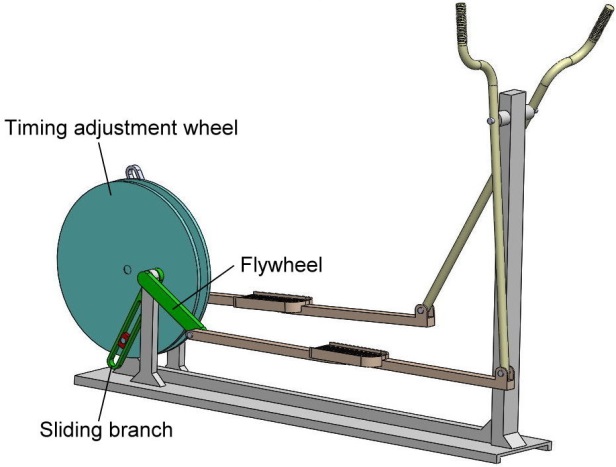Innovative Design of an Elliptical Trainer with Right Timing of the Foot Trajectory
DOI:
https://doi.org/10.46604/aiti.2020.5645Keywords:
innovative design, mechanism design, kinematics, elliptical trainerAbstract
The existing elliptical trainer cannot provide the user with the real jogging exercising mode and does not meet the principles of ergonomics. The purpose of this paper is to propose and study an innovative elliptical trainer that imitates the right timing of the foot trajectory while jogging. First of all, this study proposes and illustrates the structure and function of the innovative elliptical trainer with quick-return effect. Then, by using vector-loop method and motion geometry of the mechanism, the proposed innovative mechanism is studied kinematically. A design example is presented for interpreting the design process. At last, the foot trajectory of the innovative elliptical trainer is analyzed and confirmed. The simulation results confirm that the timing of the foot trajectory of the foot support members satisfies the principles of ergonomics, and keeps the user’s legs from injury.
References
J. H. Hoeberigs, “Factors related to the incidence of running injuries,” Sports Medicine, vol.13, no. 6, pp. 408-422, November 1992.
G. A. Hanks and A. Kalenak, Running injuries. In: Grana WA, Kalenak A, Editors. Clinical Sports Medicine. Philadelphia: W.B. Saunders Company, pp. 458-465, 1982.
A. F. Renstrom, “Mechanism, diagnosis, and treatment of running injuries,” Instructional Course Lectures, vol. 42, pp. 225-234, 1993.
T. F. Novacheck, “The biomechanics of running,” Gait and Posture, vol. 7, no. 1, pp. 77-95, January 1998.
T. W. Lu, H. L. Chien, and H. L. Chen, “Joint Loading in the lower extremities during elliptical exercise,” Medicine and Science in Sports and Exercise, vol. 39, no. 9, pp.1651-1658, September 2007.
T. W. Lu and H. L. Chien, “Dynamic analysis of the lower extremities during elliptical exercise,” Journal of Biomechanics, vol. 39, no. 1, p. S193, 2006.
J. P. Porcari, J. M. Zedaker, L. Naser, and M. Miller, “Evaluation of an elliptical exerciser in comparison to treadmill walking and running, stationary cycling, and stepping,” Medicine & Science in Sports & Exercise, vol. 30, no .5, p. 168, 1998.
J. H. Shyu, C. K. Chen, C. C. Yu, and Y. J. Luo, “Research and development of an adjustable elliptical exerciser,” Advanced Materials Research, vols. 308-310, pp. 2078-2083, August 2011.
K. M. Knutzen, W. L. McLaughlin, A. J. Lawson, B. S. Row, and L. T. Martin, “Influence of ramp position on joint biomechanics during elliptical trainer exercise,” The Open Sports Sciences Journal, vol. 3, pp. 165-177, 2010.
C. A. Nelson and J. M. Burnfield, “Improved elliptical trainer biomechanics using a modified cardan gear,” ASME 2012 International Design Engineering Technical Conferences and Computers and Information in Engineering Conference, vol. 4: 36th Mechanisms and Robotics Conference, August 2012, pp. 35-42.
Z. Yin, “Modal analysis and dynamics simulation of elliptical trainer,” International Conference on Mechatronics and Intelligent Robotics, March 2020, pp. 19-25.
C. Krishnan, E. P. Washabaugh, and Y. Seetharaman, “A low cost real-time motion tracking approach using webcam technology,” Journal of Biomechanics, vol. 48, no. 3, pp. 544-548, February 2015.
Y. Qi, C. B. Soh, E. Gunawan, and K. S. Low, “Ambulatory measurement of three-dimensional foot displacement during treadmill walking using wearable wireless ultrasonic sensor network,” IEEE Journal of Biomedical and Health Informatics, vol. 19, no. 2, pp. 446-452, March 2015.
G. H. Martin, Kinematics and dynamics of machines, 2nd ed. USA: Waveland Press, 1982.
H. S. Yan, Mechanisms: theory and applications, Singapore: McGraw-Hill, 2016.
S. N. Dwivedi, “Application of a Whitworth quick return mechanism for high velocity impacting press,” Mechanism and Machine Theory, vol. 19, no.1, pp. 51-59, 1984.
R. F. Fung and K. W. Chen, “Constant speed control of the quick return mechanism driven by a dc motor,” JSME International Journal Series C Mechanical Systems, Machine Elements and Manufacturing, vol. 40, no. 3, pp. 454-461, 1997.
R. F. Fung and F. Y. Lee, “Dynamic analysis of the flexible rod of a quick-return mechanism with time-dependent coefficients by the finite element method,” Journal of Sound and Vibration, vol. 202, no. 2, pp. 187-201, May 1997.
W. H. Hsieh and C. H. Tsai, “A study on a novel quick return mechanism,” Transactions of the Canadian Society for Mechanical Engineering, vol. 33, no. 3, pp. 487-500, March 2018.
F. C. Chen, Y. F. Tzeng, and W. R. Chen, “On the mechanism design of an innovative elliptical exerciser with quick-return effect,” International Journal of Engineering and Technology Innovation, vol. 8, no. 3, pp.228-239, July 2018.
Stationary training equipment - Part 9: Elliptical trainers, additional specific safety requirements and test methods, ISO 20957-9, pp. 1-14, 2016.

Published
How to Cite
Issue
Section
License
Submission of a manuscript implies: that the work described has not been published before that it is not under consideration for publication elsewhere; that if and when the manuscript is accepted for publication. Authors can retain copyright in their articles with no restrictions. is accepted for publication. Authors can retain copyright of their article with no restrictions.
Since Jan. 01, 2019, AITI will publish new articles with Creative Commons Attribution Non-Commercial License, under The Creative Commons Attribution Non-Commercial 4.0 International (CC BY-NC 4.0) License.
The Creative Commons Attribution Non-Commercial (CC-BY-NC) License permits use, distribution and reproduction in any medium, provided the original work is properly cited and is not used for commercial purposes.







